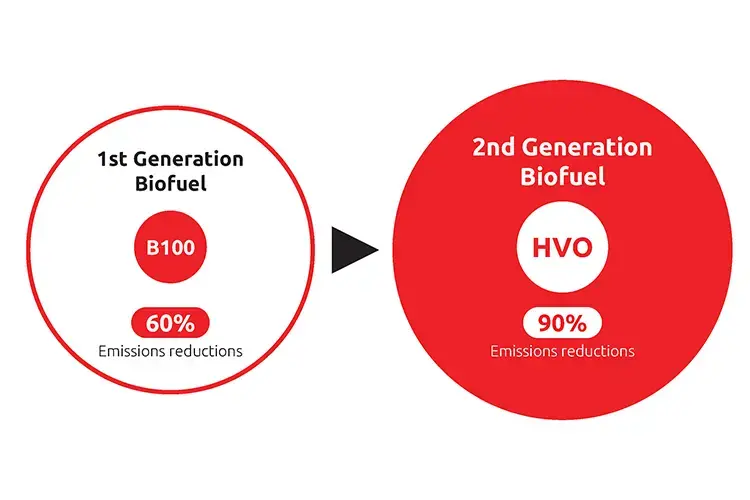Leading the way to a sustainable future with HVO
Inhaltsverzeichnis
Das Wichtigste in Kürze
- Eine schnelle Ausweitung des Ladeinfrastrukturnetzes ist erforderlich, da immer mehr E-Lkw zum Einsatz kommen.
- Milence entwickelt in Partnerschaft mit UTA Edenred ein spezialisiertes Netzwerk von Schnellladestationen für schwere Fahrzeuge in Europa.
- Verschiedene Arten von Schnellladestationen (bis zu 400 kW) sind notwendig, um die Ladezeiten zu verkürzen und die Einsatzbereitschaft von Elektro-Lkw-Flotten zu verbessern.
Hydrotreated Vegetable Oil (HVO) is revolutionising the transport sector and represents a significant shift towards more sustainable and environmentally friendly fuel solutions. As a green alternative to regular diesel, HVO stands out for its ability to reduce emissions while maintaining compatibility with existing diesel engines.
This article looks at the benefits and challenges of HVO, its performance, its impact on the environment and the wider implications for its deployment in Europe.

TOC - Inhaltsverzeichnis @ TRIALTA - Hier benötigen wir ein TOC Modul
- Thema 1
- Thema 2
- Thema 3
- Thema 4
What is HVO and HVO100?
HVO is a renewable diesel fuel produced by hydrogenating and hydrocracking various fats and vegetable oils. Sources can include rapeseed oil, waste cooking oil and animal fats. The biodiesel is called HVO100 in its pure form, rather than as a blend of HVO and diesel. Free of sulphur, oxygen and aromatic hydrocarbons, it is a sustainable and environmentally friendly alternative to fossil diesel. It has a higher heating value per kg than fossil diesel. The HVO production process involves the hydrogenation of fats or oils, where hydrogen is added to break double bonds, followed by hydrodeoxygenation and/or decarboxylation to remove oxygen from the feedstock, producing paraffinic hydrocarbons that meet specific fuel standards. This advanced production process makes it possible to produce a fuel with similar chemical properties to fossil diesel. This makes it compatible with existing modern engines without the need for modification – all Euro 6 and most Euro 5 can run on it, but always check with the manufacturer.
Smaller carbon footprint and tailpipe emissions with HVO
HVO100 diesel is known for significantly reducing greenhouse gas emissions by up to 90 % through its life cycle compared to regular diesel. It also reduces other emissions and raw materials like carbon monoxide, nitrogen oxides, and particulate matter, making it a much cleaner alternative in terms of air quality impact.
| 90 % less CO2 | 24 % less CO | 9 % less NOx | 33 % less fine particles | 30 % less hydrocarbons |
Advantages of HVO100 for fleetmanagers
HVO is not only an environmentally friendly direct replacement for conventional diesel, seamlessly integrating into existing diesel engines and enhancing sustainable mobility. Moreover, it offers a range of additional benefits that boost both environmental sustainability and operational efficiency.
- High cetane number
With a cetane number between 70 and 90, HVO offers superior ignition quality compared to fossil diesel, which typically ranges from 50 to 65. This higher cetane number enhances combustion efficiency, leading to smoother engine operation and reduced engine noise. - Free from sulphur and aromatics
HVO does not contain sulphur or aromatic compounds, which are prevalent in traditional fossil fuels. This absence not only makes it a cleaner burning option but also helps in reducing sulphur dioxide and other harmful emissions that contribute to air pollution and acid rain.

gas emissions by up to 90 % through its life cycle compared to regular diesel.
- Good cold start properties
HVO maintains good performance even at low temperatures, which is crucial for vehicles operating in colder climates. Unlike some biofuels that may gel or wax under cold conditions, HVO continues to flow freely, ensuring reliable engine starts and operation. - Compatibility with diesel engines
HVO can be utilised in diesel engines without any need for modifications. This compatibility with existing infrastructure and vehicle fleets makes it an attractive option for immediate adoption, reducing the need for costly engine overhauls or new vehicle purchases. - Renewability
Produced from renewable resources like vegetable oils, waste cooking oils, and animal fats, HVO is a sustainable fuel option. Its production from waste and residues also adds an element of waste reduction and resource efficiency to its environmental credentials. - Versatility
HVO can be used in its pure form (HVO100) or blended with conventional diesel in varying proportions such as HVO25, HVO33, or HVO50. This versatility allows for flexible usage across different needs and regulatory environments, facilitating easier transition from fossil fuels. - Simple implementation
Many sites are replacing premium diesel pumps with HVO100 pumps, eliminating the need for new infrastructure at the station. - Longer shelf life and storage stability
Compared to regular biodiesel, also known as FAME (Fatty Acid Methyl Esters), HVO demonstrates superior storage stability, which can prevent issues like oxidation and sediment formation over time. This makes it a more reliable choice for long-term storage and use in various fuel supply chains.
… and the challenges of HVO for the mobility sector?
While Hydrotreated Vegetable Oil (HVO) offers significant environmental and operational benefits, it is not without its challenges, particularly in terms of costs and regulatory approvals. The production of HVO is generally more expensive than that of fossil diesel or even other biofuels like FAME (Fatty Acid Methyl Esters). This higher cost is largely due to the complex processing required, including hydrogenation and hydrocracking of fats and oils, which also involves high capital investment in processing facilities. Additionally, the price of HVO100 can be volatile, depending on the availability and cost of feedstocks, which are subject to fluctuations in the global agricultural market.
On the regulatory side, HVO must meet stringent certifications to be approved for use in various markets. Each country or region may have specific certifications that dictate the blend ratios and usage of renewable diesels like HVO, necessitating comprehensive testing processes to ensure compliance. This can delay market entry and increase costs, further complicating the widespread adoption of HVO as a sustainable alternative fuel. However, the fact that HVO is exempt from the CO2 price increases the preference for biodiesel.
Expanding horizons: HVO's market growth across europe
HVO has seen considerable adoption across several European markets, each with its unique developments.
- In Finland, the journey began with the opening of Neste's first refinery in 2007, positioning the country as a pioneer in HVO production.
- Sweden followed suit, leveraging its domestic resources like tall oil to enhance its HVO capabilities, and today is recognised for its innovative use of renewable diesel.
- Great Britain has also participated actively in the HVO market, focusing on reducing transportation emissions through increased HVO usage.
- From spring 2024, paraffinic diesel HVO may be sold at petrol stations in Germany.
- In Spain Repsol invested in their own refinery in the south of the country and already has around 300 stations with HVO.
- In Italy Eni is promoting HVO extensively, most of the market is supplied by their two refineries, and the price of product is lower than fossil diesel.
Overview map: HVO 100 stations in Europe
| Country | Stations |
| Belgium | {$HVO 100 Stations BEL} |
| Netherlands | {$HVO 100 Stations NDL} |
| Germany | {$HVO 100 Stations DEU} |
| Finland | {$HVO 100 Stations FIN} |
| Sweden | {$HVO 100 Stations SWE} |
| Norway | {$HVO 100 Stations NOR} |
| Denmark | {$HVO 100 Stations DNK} |
| Czech Republic | {$HVO 100 Stations CZE} |
| Spain | {$HVO 100 Stations ESP} |
| Ireland | {$HVO 100 Stations IRL} |
| Italy | {$HVO 100 Stations ITA} |
| Austria | {$HVO 100 Stations AUT} |
| Latvia | {$HVO 100 Stations LVA} |
| Lithuania | {$HVO 100 Stations LTU} |
| Estonia | {$HVO 100 Stations EST} |
| France | {$HVO 100 Stations FR} |
| Slovakia | {$HVO 100 Stations SK} |
| Total | {$HVO 100 Stations Total} |

The UTA HVO network
The UTA HVO network is expanding across Europe, providing a robust infrastructure for HVO fuel. The network offers a variety of green fuel options from major suppliers such as the HVO100 fuel from Neste, Tamoil, Repsol and Circle K, catering to diverse fleet requirements and sustainability goals. This expansion includes upcoming additions in Spain, the Netherlands, and Italy, highlighting UTA Edenred’s commitment to promoting environmentally friendly transportation solutions across the continent.
